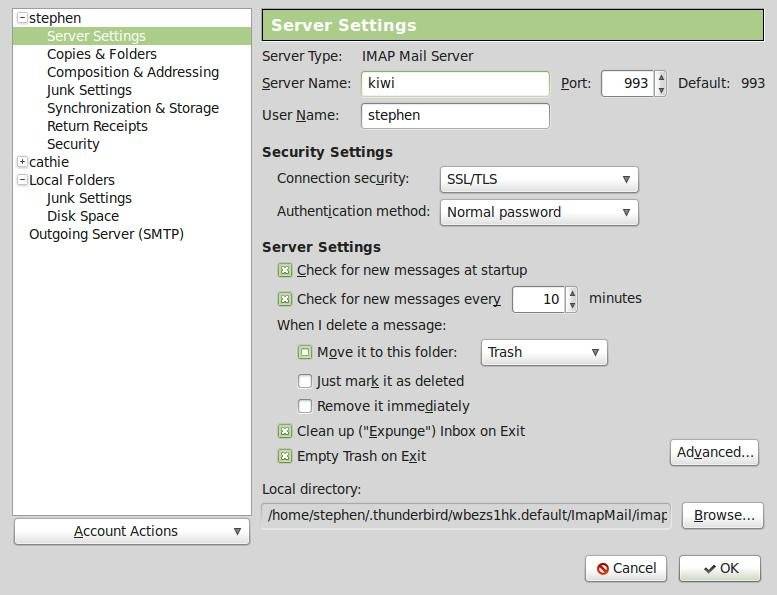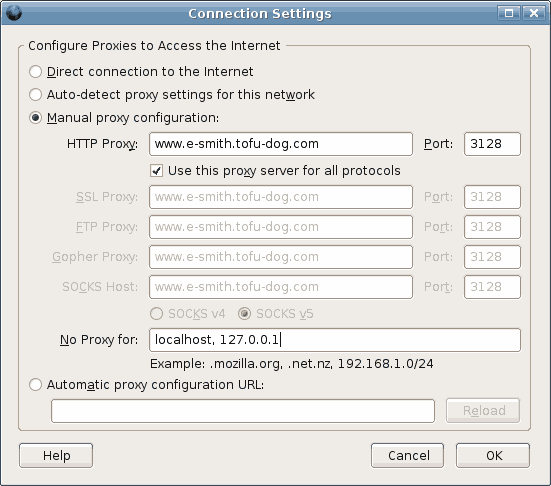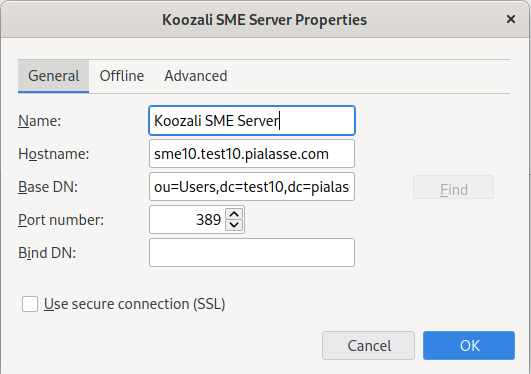Difference between revisions of "SME Server talk:Documentation:User Manual:Chapter2/fr"
(Created page with "{{Languages|SME_Server:Documentation:User_Manual:Chapter2}} == Chapitre 2 - Configuration des applications sur votre ordinateur == ===Configuring an email client=== Your emai...") |
|||
| Line 2: | Line 2: | ||
== Chapitre 2 - Configuration des applications sur votre ordinateur == | == Chapitre 2 - Configuration des applications sur votre ordinateur == | ||
| − | === | + | === Configuration d'un client de messagerie Mail === |
| − | |||
| − | + | Votre application de client de messagerie (Outlook, Thunderbird, etc) nécessite d'être mis en place avec des informations sur vos comptes de messagerie: comment acheminer le courrier électronique et les login/mot-de-passe nécessaires pour collecter et délivrer votre courrier entrant et sortant. Ces informations sont généralement à renseigner dans la section "options" ou «préférences» du client de messagerie. | |
| + | Pour la plupart des clients e-mail, vous devez saisir les informations suivantes:<br /> | ||
| − | + | Adresse e-mail de l'utilisateur: c'est le nom du compte d'utilisateur (tel que créé dans le server-manager) suivi de @nom-de-domaine. En général, il sera sous la forme de username@yourdomain.xxx (par exemple afripp@tofu-dog.com).<br /> | |
| − | + | Serveur e-mail (serveur de messagerie SMTP sortant): L'adresse du serveur de messagerie. Comme vous le préférez, vous pouvez entrer l'adresse IP de la SME Server, ou vous devriez être en mesure d'utiliser pleinement le nom de domaine du serveur, comme mail.yourdomain.xxx (par exemple mail.tofu-dog.com). | |
| − | + | Nom de compte email ou nom d'utilisateur: c'est le nom avant le signe @ dans l'adresse e-mail. Par exemple, le nom d'utilisateur "afripp@tofu-dog.com" est "afripp". | |
| − | + | Le client de messagerie peut vous offrir le choix entre les modes de fonctionnement POP3 et IMAP. | |
| − | + | Si vous choisissez le service de messagerie POP3: | |
| − | |||
| − | |||
| − | + | * Activer le protocole POP3: En règle générale, pour activer le protocole POP3 pour le courrier électronique entrant, vous cliquez sur une case POP3 ou sélectionnez POP3 à partir d'un menu déroulant dans la section de votre application de messagerie dédié au serveur de courrier entrant. | |
| + | * Désactiver le protocole IMAP: Pour désactiver le protocole IMAP pour le courrier sortant (toutes les applications de client de messagerie n'ont pas forcément de protocole IMAP) cochez la case IMAP "off". | ||
| + | * Supprimer les emails lus du serveur: Nous vous recommandons de configurer votre application client de messagerie POP3 pour supprimer chaque message sur le serveur lorsqu'il a été téléchargé sur votre application cliente. Pour ce faire, cliquez sur la case marquée off "Laisser les messages sur le serveur" ou cliquez sur la case marquée "supprimer les courrier du serveur". | ||
| − | + | Si vous choisissez le service de messagerie IMAP: | |
| − | + | * Activer le protocole IMAP: En règle générale, pour activer le protocole IMAP pour le courrier électronique entrant (note que toutes les applications client de messagerie n'offrent pas forcément le support de l'IMAP) vous cliquez sur la case IMAP ou sélectionnez IMAP à partir d'un menu déroulant dans la section de votre client de messagerie dédié au serveur de courrier entrant. | |
| − | + | * Désactiver le protocole POP3: Pour désactiver le protocole POP3 pour le courrier sortant, cochez la case POP3 "off". | |
| − | + | Les images ci-dessous montrent la séquence d'installation dans le client de messagerie Mozilla Thunderbird. | |
| − | + | D'abord, vous choisissez "Paramètres des comptes" dans le menu "Edition" et cliquez sur les serveurs de messagerie comme indiqué dans:<br /> | |
[[Image:ScreenshotAccountSettings.jpg ]] | [[Image:ScreenshotAccountSettings.jpg ]] | ||
Revision as of 08:21, 14 August 2013
Chapitre 2 - Configuration des applications sur votre ordinateur
Configuration d'un client de messagerie Mail
Votre application de client de messagerie (Outlook, Thunderbird, etc) nécessite d'être mis en place avec des informations sur vos comptes de messagerie: comment acheminer le courrier électronique et les login/mot-de-passe nécessaires pour collecter et délivrer votre courrier entrant et sortant. Ces informations sont généralement à renseigner dans la section "options" ou «préférences» du client de messagerie.
Pour la plupart des clients e-mail, vous devez saisir les informations suivantes:
Adresse e-mail de l'utilisateur: c'est le nom du compte d'utilisateur (tel que créé dans le server-manager) suivi de @nom-de-domaine. En général, il sera sous la forme de username@yourdomain.xxx (par exemple afripp@tofu-dog.com).
Serveur e-mail (serveur de messagerie SMTP sortant): L'adresse du serveur de messagerie. Comme vous le préférez, vous pouvez entrer l'adresse IP de la SME Server, ou vous devriez être en mesure d'utiliser pleinement le nom de domaine du serveur, comme mail.yourdomain.xxx (par exemple mail.tofu-dog.com).
Nom de compte email ou nom d'utilisateur: c'est le nom avant le signe @ dans l'adresse e-mail. Par exemple, le nom d'utilisateur "afripp@tofu-dog.com" est "afripp".
Le client de messagerie peut vous offrir le choix entre les modes de fonctionnement POP3 et IMAP.
Si vous choisissez le service de messagerie POP3:
- Activer le protocole POP3: En règle générale, pour activer le protocole POP3 pour le courrier électronique entrant, vous cliquez sur une case POP3 ou sélectionnez POP3 à partir d'un menu déroulant dans la section de votre application de messagerie dédié au serveur de courrier entrant.
- Désactiver le protocole IMAP: Pour désactiver le protocole IMAP pour le courrier sortant (toutes les applications de client de messagerie n'ont pas forcément de protocole IMAP) cochez la case IMAP "off".
- Supprimer les emails lus du serveur: Nous vous recommandons de configurer votre application client de messagerie POP3 pour supprimer chaque message sur le serveur lorsqu'il a été téléchargé sur votre application cliente. Pour ce faire, cliquez sur la case marquée off "Laisser les messages sur le serveur" ou cliquez sur la case marquée "supprimer les courrier du serveur".
Si vous choisissez le service de messagerie IMAP:
- Activer le protocole IMAP: En règle générale, pour activer le protocole IMAP pour le courrier électronique entrant (note que toutes les applications client de messagerie n'offrent pas forcément le support de l'IMAP) vous cliquez sur la case IMAP ou sélectionnez IMAP à partir d'un menu déroulant dans la section de votre client de messagerie dédié au serveur de courrier entrant.
- Désactiver le protocole POP3: Pour désactiver le protocole POP3 pour le courrier sortant, cochez la case POP3 "off".
Les images ci-dessous montrent la séquence d'installation dans le client de messagerie Mozilla Thunderbird.
D'abord, vous choisissez "Paramètres des comptes" dans le menu "Edition" et cliquez sur les serveurs de messagerie comme indiqué dans:
If you have not entered details about your mail server yet, you will need to press the Add button and enter some information. Otherwise, you will select the default mail server listed and click on the the Edit button. This will bring up a screen where you enter the username and choose whether you are using IMAP or POP3:
Thunderbird should now be ready to send and receive email.
IMAP versus POP3 email
There are two common standards for email management, IMAP and POP3. Your server supports both protocols. You will need to select the protocol that is right for your organization, although IMAP is favoured for almost all situations.
IMAP email, is designed to permit interactive access to multiple mailboxes from multiple client machines. You manage your email on the mail server over the network. You read your email over the network from your desktop, but the email is not stored on your desktop machine - rather, it is permanently stored and managed on the server.
Benefits of IMAP: You can access all of your new and stored email from any machine connected to a network. Because all employee email is stored on the server, backup of email is easily accomplished.
IMAP allows better overall management of email across a number of end user devices. Whatever you do on one, is reflected to all others, even adding new folders and moving messages to archive folders. eg you can send on a workstation and see all your sent messages on the phone and so on.
Whatever email you send or receive, folder changes etc at any email client including workstations, phones, remote workstations and even webmail (accessed via web browser from home or anywhere), will all show the same. You can set the email clients to retain local copies of messages if that is important.
Drawbacks of IMAP: If you are not connected to a network, new and remote stored email messages are not available to you.(stored emails can be solved with current email clients for desktop - i.e. Thunderbird option to cache the mails for offline working - some clients for mobile devices do this also, practically you'll have the last snapsot from the moment when you were online )
POP3 is an earlier and ageing email legacy protocol. POP3 was designed to permit on-demand retrieval to a single client machine. Email is stored on the mail server until you retrieve it, at which time it is transferred over the network to your desktop machine and stored in your email box there.
Benefits of POP3: Even when you are not connected to your network, you have access to the email stored on your desktop.
Drawbacks of POP3: POP3 was not originally intended to support users accessing and managing their email from remote systems. Because your email is stored on your desktop, setting up remote access of your email when you are at a different computer can be complex.
Configuring Your Web Browser
Most browsers (Internet Explorer, Firefox etc) are configured using a dialog box called "preferences", "network preferences" or "options". Some browsers need to be configured to access the Internet either directly or via a proxy server. When required, most desktop applications, your web browser included, should be configured as though they were directly accessing the Internet. Although the server uses a security feature known as IP masquerading, thereby creating an indirect connection to the Internet, this is a transparent operation to most of your desktop applications. Hence, you should ensure that the "Direct connection to the Internet" check box is clicked "on" in your web browser.
Under certain circumstances, using a proxy server can improve the perceived performance of your network. The server includes HTTP, FTP and Gopher proxy servers. Normally, we recommend these be disabled in your browser.
If you decided that you do want to use proxy servers *3, you will need to enter the IP address or domain name of the proxy server (i.e. your server) into the configuration screens of your web browser. The port number you will need to enter to connect to the proxy server is 3128. This information is the same for HTTP, Gopher and FTP proxying. Alternatively your browser can find the proxy details for itself by entering http://proxy/proxy.pac into Automatic proxy configuration URL:
The image below shows how a proxy server would be configured in Mozilla Firefox.
#3 Note that laptop users should disable proxy servers when working away from their local area networks.
Configuring Your Company Directory (Address Book)
Your SME Server automatically maintains a Directory and populates it with users names and contact details when Admin enters these in the server-manager. Any client program that uses LDAP (Lightweight Directory Access Protocol), such as the address book in Thunderbird, will be able to access the Directory - but by default this will be read-only access. For example, with Thunderbird, look under the "Tools" menu and choose "Address Book". Then look under the "File" - "New" menu and select "LDAP Directory".
You will see a dialog box similar to the one shown here.
You will need to enter the following information:
- Enter the name you wish to give your company directory - any name will do.
- The LDAP server or Hostname is the name of your web server, in the form www.yourdomain.xxx.
- The Server Root information can be found on the "Directory" screen in your server-manager (more information on this is available in the next chapter). The usual form, assuming your domain is yourdomain.xxx, is dc=yourdomain,dc=xxx . (No spaces should be entered between the "dc=" statements.)
- The Port Number is always 389.
Once the address book has been created, enter a term into the search field, if you type an @ you will list the contact details of all email accounts on the SME Server.


